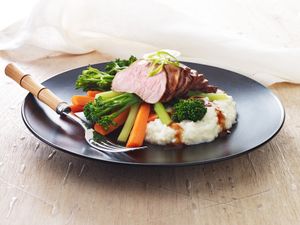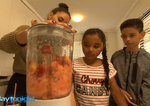Perfect portions: the size of our plates has grown (and so have our waistlines)
by Kellie-Ann Jolly, Heart Foundation Victoria's Director of Cardiovascular Health Programs
- February 18, 2016
- Leave a comment
- Families
- Health professionals
- Healthy eating
- Top Tips
- Weight Management
- Industry
- Psychology
- Nutrition Facts

When we eat out nowadays, we expect to be served a super-sized meal on a giant plate and feel ripped-off if we receive anything less. This has led to ‘portion distortion‘ which means we think these oversized meals are normal, leading us to serve ourselves similar sizes at home.
When I pulled out my parents’ dinner set at Christmas, I noticed they were much smaller than the ones we use today. The problem with using larger plates is that we are more likely to pile it high with food and eat more than we need. This can lead to weight gain or make it very hard to achieve a healthy weight. Even if the food is nutritious, healthy food still needs to be enjoyed in smaller portions.
Many of us were taught as kids to finish everything on our plate. Unfortunately this mentality often stays with us as adults, so we keep eating even after we are full. This is especially the case when we have paid for a buffet meal at a restaurant – waste not want not! While food wastage is a real concern, it is also important for us to listen to our bodies more and only eat what we need. As well as the extra kilojoules we consume, overeating can make us feel bloated, lethargic, nauseous and uncomfortable.
When eating at home, try and resist the temptation to go back for ‘seconds’ by refrigerating the leftovers. You will feel much better and your body will thank you for it. Besides, you will save having to prepare a meal for another day!
Thankfully, there are simple ways to combat portion distortion. Here are some tips to help you dish out the perfect portion size¹:
1. Use smaller plates and bowls.
This way your plate will look full, even with a smaller portion. Using smaller plates can also help you stop food wastage as you are less likely to have food left on your plate.
2. Eat slowly and mindfully
We often scoff food so quickly that we don’t realise how much we have eaten until it is all gone and we are left feeling sick. Eating mindfully means enjoying your meal without distractions such as the TV or phones, and savouring each mouthful. This will give you time to register when you are full.
3. Follow the healthy plate guidelines
Aim to fill half your plate with vegies or salad, a quarter with protein (like meat or fish) and a quarter with carbohydrate (like pasta, rice, grains etc.) Remember potatoes count towards the carbohydrate section of the plate.
4. Dish out a few servings at once and put leftovers away immediately.
This way you will be less likely to be tempted to go back for seconds.
5. Bulk up your meals with vegetables and foods with fibre
Vegies are low in kilojoules and packed with nutrients, so you can eat more of them to fill you up. Foods high in fibre like legumes and wholegrain carbohydrates will keep you feeling fuller for longer so you don’t have to load up on extra portions of high kilojoule foods.
6. Share a meal with a friend or your partner when eating out.
Try ordering one main and a side to share with a friend.
Image: LiveLighter’s Five-spice hoisin pork with cauliflower mash







